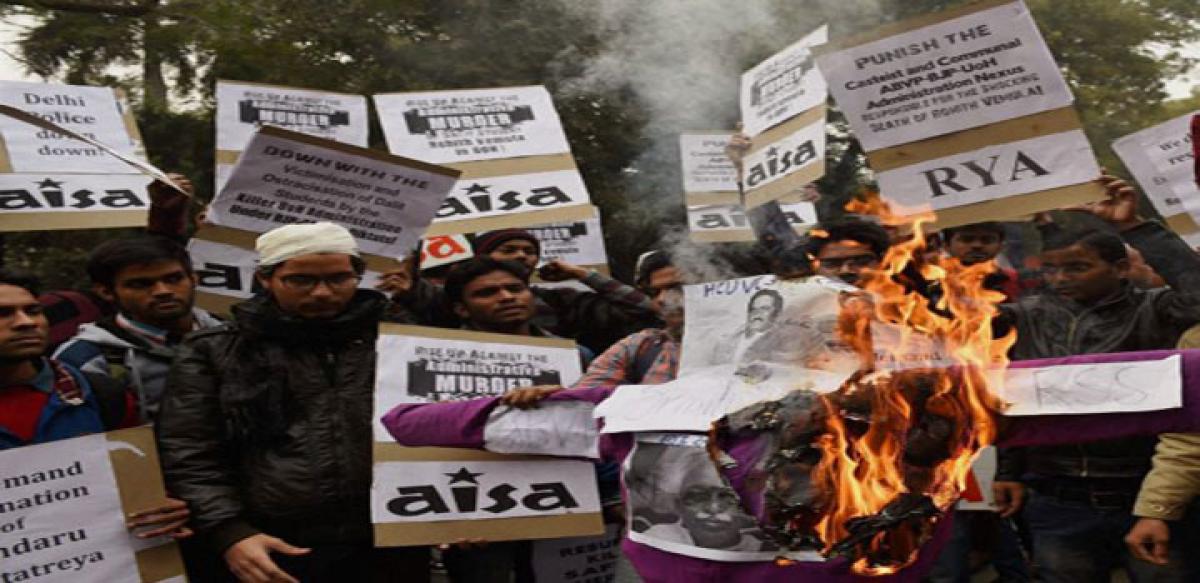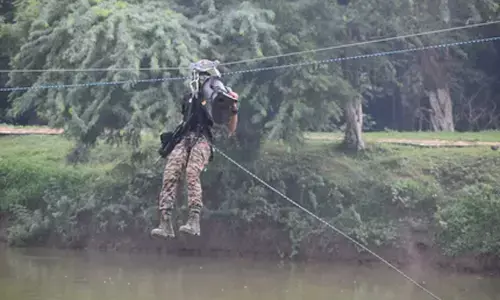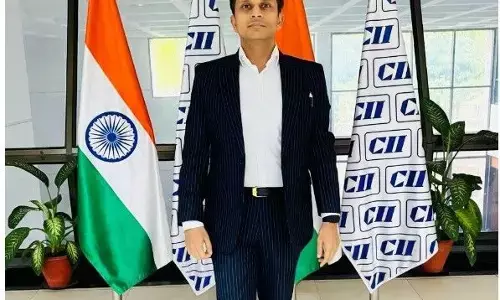Behind University of Hyderabad tragedy

The tragic death of Rohith Vemula has sparked off a national political slugfest. The nation-wide protests are understandable, given the gravity of the circumstances in which Rohith committed suicide. The incident and the series of events that culminated into this tragic end raise several pertinent questions of how to run highest academic institutions like universities and how to deal with student
There are innumerable instances of social discrimination meted out to marginalised communities in highest academic bodies, too. Unfortunately, these concerns are either taken as a normal course of social behavior or as a reflection of consolidating caste-based identities. A deeper exploration is needed into the issues of caste oppression or caste-based discrimination in universities as alleged by various social groups
The tragic death of Rohith Vemula has sparked off a national political slugfest. The nation-wide protests are understandable, given the gravity of the circumstances in which Rohith committed suicide. The incident and the series of events that culminated into this tragic end raise several pertinent questions of how to run highest academic institutions like universities and how to deal with student unrest emanating from educational campuses.
At the first instance, the death of the dalit scholar was neither accidental nor provocation of personal wishes. It is a clear case of indictment of caste discrimination. The suicide raises certain socially disturbing questions. Rohith referred to the agony of having come from a socially marginalised community.
The emergence of identity consciousness is often dismissed as a parochial manifestation without realising the legitimate concerns such a social assertion often raise. There are innumerable instances of social discrimination meted out to marginalised communities in highest academic bodies, too.
Unfortunately, these concerns are either taken as a normal course of social behavior or as a reflection of consolidating caste-based identities. A deeper exploration is needed into the issues of caste oppression or caste-based discrimination in universities as alleged by various social groups.
All that allegations of hierarchical treatment need not necessarily be true. But, the structural dimensions of the problem cannot be brushed aside. If not discrimination, a proper appreciation of social background of students may be missing while ascertaining learning achievements. A thorough probe into the allegations of caste discrimination in all its forms within the varsity campus needs to be probed and remedial measures be taken.
Anything can be negotiated but not the right to life of dignity. This is inherent in the constitutional right to life. In his suicide note, Rohith raises the question of self-respect that demands immediate attention. Education should be an instrument to overcome social and economic inequalities. But, higher education cannot be an instrument of perpetuation of social malaises.
The entire course of events reveals the utter sense of irresponsibility on the part of the university administration to resolve the student protests. In fact, the students were on hunger strike for two weeks.
The university administration should have taken proactive measures to find a solution to student protests. A negotiated solution for the student protest would have prevented the tragic death of Rohith Vemula.
In fact, it all begun with a relatively minor incident wherein a scuffle was reported between two student organisations. Such conflicts between various student groups are not uncommon. There are claims and counter-claims of physical assault. Leaving aside the veracity of these claims, the decision of the university authorities to take such an appalling action on research scholars is highly unwarranted.
Punitive action has also its limits. The dalit research scholars were subjected to a sort of social boycott. They were banned from entering hostels and all public places in the university. Such restraints on students in their own university are a violation of constitutional, legal and social rights of citizens to free movement.
There was no widespread violence that instigated the authorities to take such a drastic action. Socially ostracising students coming from such a social background in the name of punitive action is not just unheard of but reflects the caste tyranny of varsity authorities. Varsity authorities should have at least reconsidered their decision after the two-week-long protests.
But failure to do so only reflects the regimentalised approach which is uncalled for in universities and unbecoming of academic leadership. The suicide is a direct outcome of such a culpability of university authorities.
Besides, the action by the university authorities is a result of instructions from political bosses from New Delhi at the behest of local leaders belonging to a party that rules the nation. The link between student politics and politics in society is nothing new. But, such a scale of intervention to effect such an objectionable punitive action is absolutely reprehensible.
In fact, this political intervention is not just aimed at ensuring their political supremacy on premier educational campus. It is an utter display of intolerance to the views expressed by Ambedkarites. The union minister’s letter to Delhi accusing them as anti-national and anti-social elements reflects this politics of intolerance. The good governance practices demand that the issue should have been left to the university administration to handle it.
The university authorities have also displayed their vulnerability and pusillanimity before political patrons. This was possible because appointment of vice-chancellors has also become an epitome of political patronage. The vulnerability of Vice-Chancellor who otherwise can act autonomously is a direct result of the fact that the appointment at the highest institutional level is also highly politicised.
As a result, the university administration instead of resisting instructions from political bosses has religiously implemented their political mandate bringing disgrace to the university system. Universities should stand for adventure of ideas and onward march of civilisation which can only be possible through robust ideological conflict rather than physical violence.
The perpetrators of physical violence irrespective of their political or social moorings need to be punished. But, at the same time expression of ideas is a fundamental right. Neither the university administration nor the government has any right to stifle this fundamental right to free expression. This needs to be underlined as the allegation of dalit scholars is that they professed ideas that are not to the liking of the ruling dispensation at the Centre.
The issue began with dalit scholars putting posters condemning the Muzaffarnagar communal violence and the hanging of Yakub Memon. If universities do not debate such issues, who else will do so. Intolerance to ideas is the worst form of intolerance.
Questioning the hanging of Yakub Memon or condemning Muzaffarnagar communal carnage cannot be described as an anti-national or anti-social act warranting such a serious action. One can vehemently dismiss this position. But none can deny the right to express such views in a democracy.
The developments in University of Hyderabad should be seen in an overall context. The tragic demise of Rohith raises many fundamental issues pertaining to social inclusion especially in institutions of higher education. The issue, therefore, should not be seen as a confrontation between two student organisations alone.
It is not just issue between university administration and student groups. The underlying questions of social exclusion need to be thoroughly probed to ensure that Indian varsity campuses are centres of social inclusion.
The committee to enquire into the allegations of differential treatment of the SC , ST students in All India Institute of Medical Sciences (AIIMS) headed by Prof S K Thorat observed that the SC/ST students do not receive the kind of support that the other students receive from their teachers. Given the dependence of students on teachers for learning and skill, the lack of adequate support to the SC/ST reflects in performance and psychological problems.
The reports suggest that such a situation is not just confined to AIIMS only. Many elite educational institutions in India suffer from such prejudices. The University of Hyderabad is not an exception. Therefore, the student situation prevailing in UoH should be examined in the light of Thorat Committee recommendations in regard to AIIMS.
The committee observed that the SC/ST students perceived that avoidance and indifference shown towards them is associated with their caste background. It is often difficult to capture the nature of caste bias, as they are imbedded in social relations and behaviour.
The consequences of the social exclusion for the SC/ST are far more serious as this has developed into psychological problems and a sense of insecurity among the SC/ST students. The unilateral and high-handed action of the University of Hyderabad administration has further aggravated the situation.
The suicide of the student is a reflection of increased psychological insecurity. The university should review its system of punitive measures to avoid recurrence of such incidents in future. The authorities have not recognised the gravity of the social divide that has emerged over a period of time. Neither did it develop any mechanism to check this tendency of caste divides.
The universities should immediately set up a joint committee, comprising students, residents and faculty to examine and study the social atmosphere in campus and understand the reasons and also develop an insight for the social division that has emerged over a period of time.














